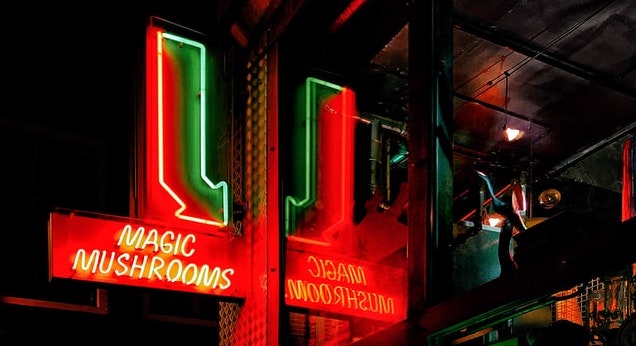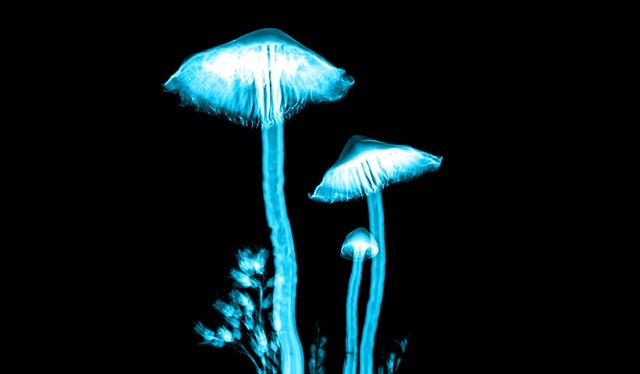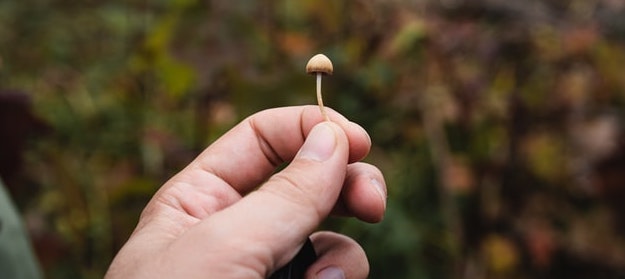Not to rest on their laurels however, mushrooms have taken it one step further — by making the music themselves.
Well, not exactly.

Of course they need a little help from us humans with opposable thumbs. But who are we to say no? Little mushies have done so much for us already.
The Musicians Making Music With Mushrooms
Ok, we are still being a little silly. But it is true — a wave of musicians have recently begun to tap into the potential of mushrooms as a music making tool. We already reported on MycoLyco (aka Noah Kalos) who’s shroom music exploded on TikTok, and even soundtracked a Stella McCartney catwalk presentation, featuring mycelium ‘leather’.

We were pretty bowled over by that. But, it turns out there are many more mushroom-virtuosos creating revolutionary bleeps, bloops and squelches — some of whom have been around for longer than you’d think.
John Cage was a Mushroom Stan
One notable mushroom loving musician was the renowned composer and artist John Cage. Famous for his silent composition 4’33’’ and other avant garde pieces, he also co-founded the New York Mycological society. In 1959, he even won an Italian game show with his specialist subject — not music as you may expect, but mushrooms. He interspersed performances of his trippy compositions in betweens rounds — no doubt bamboozling the viewers at home. However, despite his mycological obsession, foraging, studying, consuming, Cage was never moved to explore their sounds. In an essay in his publication A Music Lover’s Field Companion, Cage joked;
“I would like to emphasise that I am not interested in the relationships between sounds and mushrooms any more than I am in those between sounds and other sounds.”

That said, Gary Lincoff, a former president of the North American Mycological Society shared of his friend;
“Cage believed he could hear the mushrooms in the woods, but I think [he said it] with tongue in cheek.”
Rhythms of the Earth
So as you see, mushrooms have intrigued some of the most creative musical minds. Perhaps it is their deep connection to the rhythms of the earth.
However, one of the first musicians to actually make the mushroom an instrument was an artist called Mileece. Beginning her exploration over 20 years ago, Mileece was inspired by the importance of preserving biodiversity and halting climate change. This was long before climate change became a widely acknowledged threat. She told The Guardian;
“I was called all sorts of bad words for being an environmentalist. And there is no difference between what Greta Thunberg says and what I said, but everyone kind of hated me for it.”
Pot Plants and Home Made Electrodes
Mileece learned sound engineering and coding when she was a teenager. She went on to be a resident artist at the London School of Economics, during which she developed a technique to transcribe electrical signals from plants into basic sound design elements. Early experiments included a pot plant kitted out with self-made hair clip-electrodes connected to a custom-made module and synth, linked to an old-school Mac computer.

Since then, Mileece has spent her career developing plant bio-emission translating software and hardware to create what she calls “aesthetic sonification”. In 2019 she created an installation at Tate Modern, London, that consisted of a pod full of plants and flowers that created music when they reacted to people entering and moving around the space. Her practice is still deeply concerned with highlighting the threat to our environment via climate change.
Translating the Vibrations
Tarun Nayar is another fungi-virtuoso. He started his exploration relatively recently, with his project Modern Biology only beginning last summer. However, he has already pulled in over half a million TikTok followers and 25 million views with his calming videos of mushrooms creating ambient sounds. A former biologist, he spends his summers in the Gulf Islands of British Columbia with mushroom royalty the Sheldrake Brothers. (You may know Merlin Sheldrake as the author of Entangled Life: How Fungi Make Our Worlds, Change Our Minds and Shape Our Futures) It was here, and via their influence he began to be a mushroom stan. He was foraging — but not always to eat them. Also to hear them.

His first plant experiment took place while summering with his friends. He spotted a thimbleberry plant growing just outside his cabin. After connecting the leaves to a software synthesizer which could play the piano, he heard the music. The bioelectrical energy of the plants triggers note changes as it fluctuates. Nayar describes the process as “an environmental feedback mechanism. It’s based on galvanic resistance – the same principle by which simple lie detectors work.”
Growing up, Nayar listened to a lot of Indian classical music including Ravi Shankar. Much of this genre of music is based on vibration, and hence when putting together his plant-sounds Nayar often uses the structure of the traditional Indian raga to translate what he hears.
Music to Connect Us to the Natural World
What all these artists are doing is novel and cool — pretty wacky really. But there is a deeper ambition than simply setting TikTok alight. These artists believe that giving a voice or sonic element to plants and fungi is an essential part of growing a deeper connection with the natural world. This is key if we mean to move forward and heal the world of the damage we have caused. Acknowledging we are all part of the same ecosystem, supporting each other is key. As Nayar explains;
“When people are doom-scrolling on TikTok and all of a sudden a little mushroom pops up, that’s a moment of reconnecting, even if it’s through a phone. If music and tuning in more deeply can bring us here right now, then there’s hope.”






